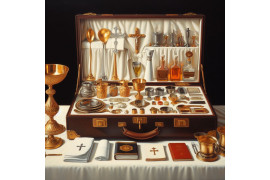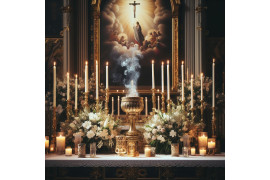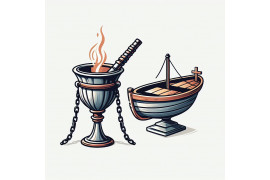A communion pyx is a small container used to carry consecrated hosts for distribution to the sick or home bound. Its purpose is to ensure that the Eucharist remains sacred and protected during transportation. Typically made of metal, such as gold or silver, pyxes often have a lid with a cross on top.
In the Catholic Church, the ownership of a pyx can vary. It is commonly owned by the parish or church where it is used for administering Holy Communion. However, in some cases, individuals may also own their personal pyxes for specific purposes, like bringing the Eucharist to someone in need.
Understanding who owns a pyx in the Catholic context helps maintain reverence and respect for this important religious artifact.
Norms and Guidelines for Administering Holy Communion with a Pyx
There are specific norms and guidelines that must be followed. These rules ensure that the Eucharist is handled reverently and distributed in accordance with the teachings of the Catholic Church. Let's take a closer look at these norms and guidelines.
Proper Authorization from the Church
Firstly, it is important to note that the use of a pyx requires proper authorization from the Church. This authorization is typically granted to extraordinary ministers of Holy Communion who have been designated by their local parish or diocese. These individuals receive special training to handle and distribute the Eucharist using a pyx.
Handling the Eucharist Reverently
When administering Holy Communion with a pyx, it is crucial to handle the Eucharist reverently. This means treating the blessed sacrament with the utmost respect and care. Extraordinary ministers should approach this task with humility and devotion, recognizing that they are handling something sacred.
Following Specific Guidelines
To ensure proper administration of Holy Communion with a pyx, there are specific guidelines set by the Church that must be followed. These guidelines include:
-
Preparing the Pyx: Before Mass or another liturgical celebration, extraordinary ministers should make sure their pyxes are clean and suitable for holding hosts. The pyx should be lined with an appropriate cloth or purificator.
-
Receiving Holy Communion: When receiving Holy Communion themselves, extraordinary ministers should do so appropriately before distributing communion to others.
-
Approaching the Tabernacle: When approaching the tabernacle to receive hosts for distribution, extraordinary ministers should reverence it by genuflecting or bowing before opening it.
-
Filling the Pyx: Extraordinary ministers should carefully fill their pyxes without touching the hosts with their hands. They should use a purificator or other appropriate means to transfer the hosts.
-
Closing and Securing the Pyx: After filling the pyx, it should be closed securely and transported respectfully, such as being placed in a bag or pocket close to the body.
-
Distributing Holy Communion: Extraordinary ministers should distribute Holy Communion with reverence and care, ensuring that each communicant receives the Eucharist properly.
-
Returning Unused Hosts: If there are any hosts remaining in the pyx after distribution, they should be returned to the tabernacle immediately following Mass or another liturgical celebration.
By adhering to these guidelines, extraordinary ministers of Holy Communion can ensure that the Eucharist is treated with the respect it deserves, and that communion is administered in a dignified manner.
Importance and Significance of the Pyx in the Catholic Church
The pyx holds great significance in the Catholic Church, as it plays a crucial role in the distribution of Holy Communion outside of Mass. This allows individuals who are unable to attend regular church services to still receive Christ's body.
The use of a pyx symbolizes reverence for the Eucharist and reminds Catholics of its sacred nature. It serves as a tangible reminder that the bread consecrated during Mass is not just ordinary bread but rather the body of Christ. By using a pyx, priests and ministers demonstrate their deep respect for this holy sacrament.
Moreover, the pyx shows care and consideration for those who are unable to physically participate in regular Mass celebrations. It ensures that individuals who are sick, home bound, or residing in healthcare facilities can still partake in receiving Holy Communion. This inclusivity is an essential aspect of the Catholic faith, as it emphasizes that all members should have access to this central sacrament.
The use of a pyx also enables priests to bring Holy Communion to those who may be confined due to illness or other circumstances. This act of bringing Christ's presence directly to individuals' homes or hospital rooms is deeply meaningful and provides spiritual nourishment during challenging times.
In addition to its practical function, the pyx holds symbolic value within the Catholic Church. It represents both unity and community among believers. When a priest carries the consecrated hosts in a pyx, they carry with them not only their own faith but also the collective faith of their congregation.
Furthermore, when distributing Holy Communion from a pyx, priests follow specific guidelines established by the Church. These guidelines ensure that proper reverence is maintained throughout the process and that each person receives communion with dignity and respect.
To summarize:
-
The pyx holds great significance as it allows for the distribution of Holy Communion outside of Mass.
-
It symbolizes reverence for the Eucharist and reminds Catholics of its sacred nature.
-
The use of a pyx demonstrates care for those who are unable to physically participate in regular Mass celebrations.
Eastern Christianity's Perspective on Pyx Ownership
In Eastern Christianity, the ownership of personal pyxes is less common compared to Western traditions. Unlike in the Western Church, where individual ownership of pyxes is more prevalent, in Eastern Christian churches, it is typically only clergy members or ordained individuals who possess personal pyxes.
The focus in Eastern Christianity is more on communal reception rather than individual ownership. The emphasis lies on the Eucharist as a shared experience among the faithful, rather than on personal possession of the consecrated hosts.
Less Common Ownership
Unlike in Western traditions, where laypeople and even altar servers may own personal pyxes to carry consecrated hosts for distribution to the sick or home bound, this practice is less common in Eastern Christianity. Personal pyxes are primarily associated with clergy members who have been ordained and are responsible for administering the sacraments.
Emphasis on Communal Reception
Eastern Christian churches place a strong emphasis on communal reception of the Eucharist during liturgical services. The focus is on partaking together as a community and experiencing the presence of Christ through the shared sacrament. This communal aspect highlights unity and solidarity among believers.
Clergy Responsibility
In Eastern Christianity, it is primarily the responsibility of clergy members to ensure that consecrated hosts are properly handled and distributed. They play a vital role in administering communion during church services and taking communion to those unable to attend.
Importance of Divine Mysteries
Eastern Christians view the Eucharist as one of the Divine Mysteries (Sacraments) that connect them with God's grace. The handling and distribution of consecrated hosts require reverence and respect due to their sacred nature. This responsibility falls mainly upon ordained individuals, who have undergone specific training for their roles within the church hierarchy.
Symbolic Representation
The absence of personal pyx ownership among laypeople in Eastern Christianity symbolizes their reliance on clergy members for spiritual guidance and the administration of sacraments. This distinction highlights the unique roles and responsibilities within the church community.
Historical References on Pyx Ownership in Eastern Christianity
Historical records reveal interesting insights into the ownership of pyxes in early Eastern Christian communities. It appears that personal ownership of pyxes was not widespread among laypeople during this period. Instead, it was primarily associated with clergy members who required them for their pastoral duties.
In antiquity and throughout the Middle Ages, the use of pyxes was closely tied to the liturgical practices of Eastern Christianity. These small containers were used to hold the consecrated Eucharistic bread (also known as the Host) outside the celebration of Mass. The pyx allowed for easy transportation and distribution of the Eucharist to those unable to attend church services due to illness or other reasons.
The tradition of personal possession of pyxes by clergy members has been maintained in many Eastern Christian churches to this day. This practice is rooted in the belief that only ordained priests have the authority to handle and distribute the Eucharist. As such, they are entrusted with a pyx as part of their sacred duty.
One reason for this historical distinction between clergy and laypeople regarding pyx ownership may be attributed to the significance placed on proper reverence and respect for the Eucharist within Eastern Christianity. The Eucharist is considered a central sacrament, representing Christ's body and blood, and is treated with utmost reverence.
It should be noted that while personal ownership of pyxes by laypeople may not have been prevalent historically, there are exceptions based on specific circumstances or cultural variations within Eastern Christian communities. For example, in some instances where a person served as a Eucharistic minister or had a special role in bringing communion to home bound individuals, they might have been granted temporary possession of a pyx for that purpose.
Furthermore, it is important to recognize that practices may vary among different Eastern Christian traditions and regions. While some churches strictly adhere to traditional norms regarding pyx ownership, others may have adapted their practices over time to accommodate changing circumstances or cultural contexts.
Different Types of Burse for Pyx: Gold Cross Accent, Black Leather, Snap Button Cord
A gold cross accent burse is a popular choice for pyxes. These burses feature an embroidered or metal cross on the front, adding a touch of elegance and religious symbolism. The gold cross accent enhances the visual appeal of the pyx and makes it stand out during religious ceremonies.
Black leather burses provide a classic and durable option for protecting pyxes during transportation. Made from genuine leather, these burses are designed to withstand wear and tear while keeping the pyx safe. The black color gives them a timeless look that complements any style or setting.
Snap button cord burses offer convenience with easy access to the pyx while keeping it securely enclosed. These burses typically have a neck cord with snap buttons that allow for quick opening and closing. They ensure that the pyx remains protected during transport while providing easy accessibility when needed.
Here are some key features and benefits of each type of burse:
Gold Cross Accent Burse
-
Features an embroidered or metal cross on the front.
-
Adds a touch of elegance and religious symbolism.
-
Enhances the visual appeal of the pyx.
-
Comes in various sizes to accommodate different pyx dimensions.
-
Provides a stylish way to carry and present the pyx during religious services.
Black Leather Burse
-
Made from genuine leather for durability.
-
Protects the pyx from scratches, dust, and other damage.
-
Offers a classic and timeless look.
-
Available in different sizes to fit various pyx dimensions.
-
Ideal for both everyday use and special occasions.
Snap Button Cord Burse
-
Allows for quick access to the pyx with snap buttons.
-
Keeps the pyx securely enclosed during transportation.
-
Provides convenience for priests or ministers who need frequent access to the Eucharist.
-
Comes with an adjustable neck cord for comfortable wear.
-
Offers a practical and efficient way to carry the pyx.
Stylish and Practical Burse Options for Pyx
We also discussed different types of burse options for pyxes, such as the gold cross accent, black leather, and snap button cord styles.
To conclude, it is evident that selecting a stylish and practical burse for your pyx is essential to ensure its safekeeping and proper presentation during Holy Communion. Whether you prefer a traditional design with a gold cross accent or a more contemporary option like black leather or snap button cord, investing in a high-quality burse will protect your pyx and enhance its overall aesthetic appeal.
We encourage you to explore our wide range of burse options for pyxes and choose one that aligns with your personal style and preferences. By investing in a quality burse, you can demonstrate reverence for the sacred vessel used in administering Holy Communion while adding an elegant touch to your religious practices.
FAQs
Can I use any type of bag or pouch as a burse for my pyx?
No, it is recommended to use specialized burse options designed specifically for holding pyxes. These burses are crafted with materials that provide adequate protection for the sacred vessel while maintaining its integrity.
Are there different sizes available for pyx burses?
Yes, there are various sizes available to accommodate different sizes of pyxes. When choosing a burse, make sure to select one that fits your specific pyx dimensions snugly to prevent any movement or damage during transportation.
Can I personalize my burse with custom embroidery or engravings?
Some manufacturers offer customization options such as embroidery or engravings on their burses. This allows you to add personal touches like initials or religious symbols to make your burse unique and meaningful.
How do I clean and maintain my pyx burse?
The cleaning and maintenance instructions may vary depending on the material of the burse. It is best to refer to the manufacturer's guidelines for specific care instructions. In general, avoid using harsh chemicals or abrasive materials that could damage the fabric or embellishments.
Can I use a burse for purposes other than holding a pyx?
While burses are primarily designed for carrying pyxes, they can also be used to hold other small religious items like rosaries or medals. However, it is recommended to dedicate a burse exclusively for your pyx to maintain its sacredness and prevent any cross-contamination with other objects.
These FAQs aim to address common queries regarding pyx burses and their usage. If you have further questions or require more detailed information, please feel free to reach out to our customer support team, who will be happy to assist you in making an informed purchase decision.



